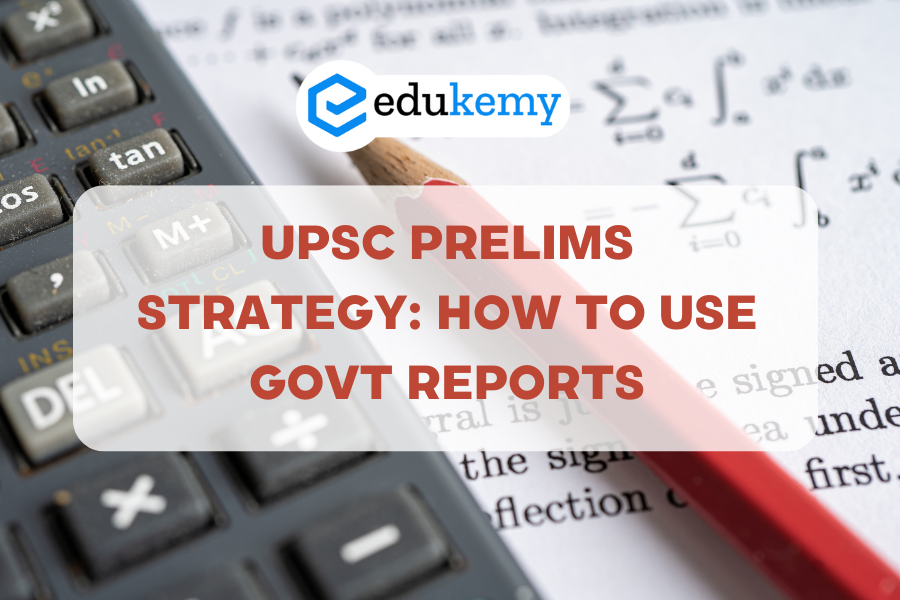Enhance your UPSC Prelims strategy with government reports and data. Gain key insights, stats, and policy details to boost your 2025 exam preparation.

Contents
- 1 Introduction
- 2 Why Government Reports and Data Matter for UPSC Prelims:
- 3 Key Government Reports and Data Sources to Focus On (Essential for your Prelims Strategy):
- 4 How to Effectively Utilize Government Reports and Data in your Prelims Strategy:
- 5 Example:
- 6 Conclusion:
- 7 To get free counseling/support on UPSC preparation from expert mentors please call 9773890604
Introduction
In the competitive landscape of the UPSC Civil Services Prelims examination, a well-rounded prelims strategy is paramount. While a broad understanding of current affairs and static subjects is essential, leveraging the power of government reports and data can provide a significant edge. These authentic sources offer valuable insights, statistics, and policy perspectives that are directly relevant to the exam.
Why Government Reports and Data Matter for UPSC Prelims:
- Authenticity and Credibility: Government reports are primary sources of information, providing the most accurate and reliable data on various issues. They are free from biases that may be present in secondary sources.
- Policy Perspective: These reports often outline government policies, initiatives, and their intended impact. Understanding these perspectives is crucial for answering policy-related questions in the Prelims exam.
- Data-Driven Insights: The UPSC Prelims often includes questions that require factual knowledge and data analysis. Government reports provide the necessary data to answer these questions accurately.
- Understanding Trends: Analyzing data from government reports helps in understanding trends, patterns, and challenges related to various sectors of the economy, society, and environment.
- Supporting Arguments: Government data can be used to substantiate your arguments and demonstrate a deeper understanding of the issues in the UPSC Mains examination (which follows Prelims). While the focus here is Prelims, this foundational knowledge is beneficial down the line.
Key Government Reports and Data Sources to Focus On (Essential for your Prelims Strategy):
- Economic Survey: This annual report provides a comprehensive overview of the Indian economy, including key economic indicators, sectoral performance, and policy initiatives. It’s a goldmine of information for Prelims preparation.
- NITI Aayog Reports: NITI Aayog’s reports cover a wide range of topics, including sustainable development goals, social sector issues, and governance reforms. They offer valuable insights into the government’s vision and priorities.
- Census of India: The Census provides detailed demographic data on population, literacy, occupation, and other socio-economic indicators. This data is crucial for understanding social issues and planning.
- National Sample Survey Organisation (NSSO) Reports: NSSO surveys collect data on various aspects of the economy and society, including employment, poverty, health, and education. These reports offer valuable insights into the ground realities.
- India Year Book: This annual publication provides a comprehensive overview of the country’s geography, history, polity, economy, and social structure. It’s a useful reference for basic information.
- Ministry-Specific Reports: Reports published by various ministries, such as the Ministry of Agriculture, Ministry of Environment, and Ministry of Health, provide detailed information on specific sectors.
- World Bank/IMF Reports: Reports from international organizations like the World Bank and IMF offer data and analysis on global economic trends and India’s position in the world. While not strictly “government” reports, they are vital for understanding India’s place in the global context.
How to Effectively Utilize Government Reports and Data in your Prelims Strategy:
- Prioritize Relevant Information: It’s impossible to read every government report. Focus on reports that are relevant to the UPSC syllabus and current events. Your prelims strategy should include targeted research, not just blanket reading.
- Summarize Key Findings: Don’t just read the reports; summarize the key findings, data points, and policy recommendations. This will make it easier to revise the information later.
- Connect with Current Affairs: Try to connect the data and information in the reports with current events. This will help you understand the context and implications of the issues.
- Analyze Data and Trends: Don’t just memorize data; try to analyze the trends and patterns. This will help you answer analytical questions in the Prelims exam.
- Integrate with Static Syllabus: Connect the information in the reports with the static portions of the syllabus. This will help you understand the interlinkages between different topics.
- Practice Data Interpretation: Practice interpreting data presented in charts, graphs, and tables. This is an important skill for the Prelims exam.
Example:
If the Economic Survey reports a decline in agricultural growth, try to understand the reasons for this decline and its potential impact on the economy. Connect this with issues like food security, farmer distress, and government policies related to agriculture.
Conclusion:
Integrating government reports and data into your prelims strategy is crucial for success in the UPSC Prelims 2025. By effectively utilizing these authentic sources, you can gain a deeper understanding of the issues, improve your analytical skills, and increase your chances of scoring well in the exam. Remember, it’s not just about reading the reports, but about understanding the information, analyzing the data, and connecting it with the broader UPSC syllabus.
To get free counseling/support on UPSC preparation from expert mentors please call 9773890604
- Join Geography Optional Course – Click Here
- Get Geography Hard Copy notes – Click Here

